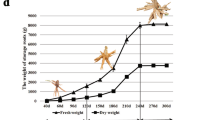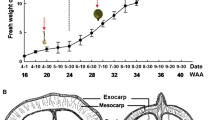Abstract
The cellular pathway of sugar uptake in developing cotyledons of Vicia faba L. and Phaseolus vulgaris L. seed was evaluated using a physiological approach. The cotyledon interface with the seed coat is characterised by a specialised dermal cell complex. In the case of Vicia faba cotyledons, the epidermal component of the dermal cell complex is composed of transfer cells. Sucrose is the major sugar presented to the outer surface of both cotyledons and it is taken up from the apoplasm unaltered. Estimated sucrose concentrations within the apparent free space of Vicia and Phaseolus cotyledons were 105 and 113 mM respectively. Rates of in-vitro uptake of [14C]sucrose by cotyledon segments or by whole cotyledons following physical removal or porter inactivation of the outer cells demonstrated that, for both Vicia and Phaseolus cotyledons, the dermal cell complexes are the most intense sites of sucrose uptake. Accumulation of [14C]sucrose in the storage parenchyma of whole cotyledons was directly affected by experimental manipulation of uptake by the outer cell layers and plasmolytic disruption of the interconnecting plasmodesmata. These findings indicated that sucrose accumulated by the dermal cell complexes is transported symplasmically to the storage parenchyma. Overall, it is concluded that the dermal cell complexes of the developing legume embryo, irrespective of the presence or absence of wall ingrowths, are the major sites for the uptake of sucrose released from the maternal tissues to the seed apoplasm. Thereafter, the accumulated sucrose is transported radially inward through the symplast to the storage parenchyma.
Similar content being viewed by others
Abbreviations
- AFS:
-
apparent free space
- CF:
-
5-(6)-carboxyfluorescein
- CFDA:
-
5-(6)-carboxyfluorescein diacetate
- Mes:
-
2-(N-morpholino)ethanesulfonic acid
- PCMBS:
-
p-chloromercuribenzenesulfonic acid
- SRG:
-
sulphorhodamine G
References
Bonnemain, J.L., Bourquin, S., Renault, S., Offler, C., Fisher, D.G. (1991) Transfer cells: structure and physiology. In: Recent advances in phloem transport and assimilate compartmentation, pp. 74–83, Bonnemain, J.L., Delrot, S., Dainty, J., Lucas, W.J. eds. Ouest. Cedex
Bouche-Pillon, S., Fleurat-Lessard, P., Serrano, R., Bonnemain, J-L. (1994) Asymmetric distribution of the plasma-membrane H+ — ATPase in embryos of Vicia faba L. with special reference to transfer cells. Planta 193, 392–397
Briarty, L.G., Coult, D.A., Boulter, D. (1969) Protein bodies of developing seeds of Vicia faba. J. Exp. Bot. 20, 358–372
Canny, M.J. (1988) Bundle sheath tissues of legume leaves as a site of recovery of solutes from the transpiration stream. Physiol. Plant. 73, 457–464
Clifford, P.E., Offler, C.E., Patrick, J.W. (1986) Growth regulators have rapid effects on photosynthate unloading from seed coats of Phaseolus vulgaris L. Plant Physiol. 80, 635–637
Felker, F.C., Shannon, J.C. (1980) Movement of 14C-labelled assimilates into kernels of Zea mays L. III. An anatomical examination and microautoradiographic study of assimilate transfer. Plant Physiol. 65, 864–870
Gaff, D.F., Okong'O-Ogola, O. (1971) The use of non-permeating pigments for testing the survival of cells. J. Exp. Bot. 22, 756–758
Gifford, R.M., Thorne, J.H. (1985) Sucrose concentrations at the apoplastic interface between seed coat and cotyledons of developing soybean seeds. Plant Physiol. 77, 863–868
Goodall, H., Johnson, M.H. (1982) Use of carboxyfluorescein diacetate to study formation of permeable channels between mouse blastomeres. Nature 295, 524–526
Griffith, S.M., Jones, R.J., Brenner, M.L. (1987) In vitro sugar transport in Zea mays L. kernels. l. Characteristics of sugar absorption and metabolism by developing maize endosperm. Plant Physiol. 84, 467–471
Maness, N.O., McBee, G.G. (1986) Role of the placental sac in endosperm carbohydrate import in sorghum caryopses. Crop Sci. 26, 1201–1207
M'Batchi, B., Pichelin, D., Delrot, S. (1987) Selective solubilization of membrane proteins differentially labelled by p-chloromercuribenzenesulfonic acid in the presence of sucrose. Plant Physiol. 83, 541–545
Offler, C.E., Nerlich, S.M., Patrick, J.W. (1989) Pathway of photosynthate transfer in the developing seed of Vicia faba L. Transfer in relation to seed anatomy. J. Exp. Bot. 40, 769–780
Oparka, K.J., Gates, P. (1981) Transport of assimilates in the developing caryopsis of rice (Oryza sativa L.). Planta 152, 388–396
Pate, J.S. (1984) The carbon and nitrogen nutrition of fruit and seed — Case studies of selected legumes. In: Seed physiology, pp. 41–81, Murray, D.R. ed. Academic Press, New York
Patrick, J.W. (1993) Osmotic regulation of assimilate unloading from seed coats of Vicia faba L. Assimilate partitioning to and within attached seed coats. Physiol. Plant. 87, 345–352
Patrick, J.W. (1994) Turgor-dependent unloading of assimilates from coats of developing legume seed. Assessment of the significance of the phenomenon in the whole plant. Physiol. Plant 90, 645–654
Patrick, J.W., McDonald, R. (1980) Pathway of carbon transport within developing ovules of Phaseolus vulgaris L. Aust. J. Plant Physiol. 7, 671–684
Richter, E. Ehwald, R. (1983) Apoplastic mobility of sucrose in storage parenchyma of sugar beet. Physiol. Plant. 58, 263–268
Thorne, J.H. (1982) Characterization of the active sucrose transport system of immature soybean embryos. Plant Physiol. 70, 953–958
Thorne, J.H. (1985) Phloem unloading of C and N assimilates in developing seeds. Annu. Rev. Plant Physiol. 36, 317–343
Walbot, V., Clutter, M., Sussex, I.M. 1972 Reproductive development and embryogeny in Phaseolus. Phytomorphology. 22, 59–68
Wang, H.L., Patrick, J.W., Offler, C.E., Wang, X.-D. (1995a) Cellular pathway of photosynthate transfer in the developing wheat grain. III. A structural analysis and physiological studies of the pathway from the endosperm cavity to the starchy endosperm. Plant Cell Environ., in press
Wang, S-D., Harrington, G., Patrick, J.W., Offler, C.E. (1995b) Cellular pathway of photosynthate transport in coats of developing seed of Vicia faba L. and Phaseolus vulgaris L. II. Principal cellular site(s) of efflux. J. Exp. Bot. 46, 49–63
Wolswinkel, P. (1992) Transport of nutrients into developing seeds: a review of physiological mechanisms. Seed Sci. Res. 2, 59–73
Zee, S-Y., O'Brien, T.P. (1971) Aleurone transfer cells and other structural features of the spikelet of millet. Aust. J. Biol. Sci. 24, 391–395
Author information
Authors and Affiliations
Corresponding author
Additional information
The investigation was supported by funds from the Research Management Committee, The University of Newcastle and the Australian Research Council. One of us, R. McDonald, gratefully acknowledges the support of an Australian Postgraduate Research Award. We are grateful to Stella Savoury for preparing the photomicrographs.
Rights and permissions
About this article
Cite this article
McDonald, R., Wang, H.L., Patrick, J.W. et al. The cellular pathway of sucrose transport in developing cotyledons of Vicia faba L. and Phaseolus vulgaris L.: a physiological assessment. Planta 196, 659–667 (1995). https://doi.org/10.1007/BF00197329
Received:
Accepted:
Issue Date:
DOI: https://doi.org/10.1007/BF00197329




